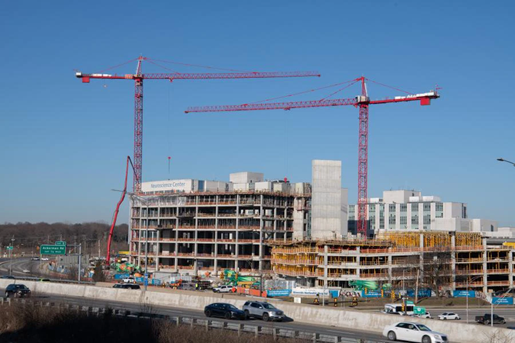
Tower cranes provide tremendous lifting power while maintaining a small footprint on jobsites, making them an excellent choice for long-term projects that require a high volume of lifts. However, it’s not always clear which type of tower crane is best suited for your projects.
When investing in a tower crane, understanding the key differences between available types can significantly affect your project's efficiency and success. Let's explore the four main types of tower cranes and how their unique characteristics can benefit different jobs.
Hammerhead Tower Cranes
These iconic cranes are characterized by their distinctive horizontal jib and counterweight, creating a silhouette of a massive “T” in the skyline. Their fixed horizontal jib provides consistent lift capacity and exceptional working radius thanks to extended arm lengths and 360-degree rotation. Hammerhead cranes excel in situations where maximum reach and lift capacity are crucial, such as high-rise construction.
Flat Top Tower Cranes
Flat top tower cranes are similar to the hammerhead cranes, except that they don’t have a top that extends above the jib. The absence of an extra A frame or cat-head structure makes for a simpler design that is typically quicker and easier to transport, assemble, and erect. They also require less height clearance, which can be beneficial when working around other cranes.
Flat top tower cranes are similar to the hammerhead cranes, except that they don’t have a top that extends above the jib. The absence of an extra A frame or cat-head structure makes for a simpler design that is typically quicker and easier to transport, assemble, and erect. They also require less height clearance, which can be beneficial when working around other cranes.
Luffing Tower Cranes
Luffing tower cranes trade the fixed, horizontal jib for a lattice jib that can move up and down for added versatility. This feature allows operators to work around buildings and other existing obstacles that would impede other tower cranes, making them ideal for more confined spaces like complex urban projects.
Luffing tower cranes trade the fixed, horizontal jib for a lattice jib that can move up and down for added versatility. This feature allows operators to work around buildings and other existing obstacles that would impede other tower cranes, making them ideal for more confined spaces like complex urban projects.
Mobile Self-Erecting
While most tower cranes are fixed in a single spot, mobile self-erecting tower cranes are smaller versions that allow for easier transportation and assembly. They typically offer lower maximum capacities compared to other tower cranes, but their shorter setup times and minimal foundation requirements can significantly reduce project costs and complexity. Their ability to self-deploy and relocate quickly makes them ideal for shorter-duration projects or jobs where the crane would need to move from one spot to another.
While most tower cranes are fixed in a single spot, mobile self-erecting tower cranes are smaller versions that allow for easier transportation and assembly. They typically offer lower maximum capacities compared to other tower cranes, but their shorter setup times and minimal foundation requirements can significantly reduce project costs and complexity. Their ability to self-deploy and relocate quickly makes them ideal for shorter-duration projects or jobs where the crane would need to move from one spot to another.
Considerations for Selecting the Right Tower Crane
Each type of tower crane offers specific benefits that can make one better than another for your needs. There are several factors that should guide your tower crane selection:
- Project Duration: Longer projects can better absorb the setup costs of traditional tower cranes, while shorter projects might favor mobile self-erecting options.
- Site Constraints: Consider overhead restrictions, adjacent buildings, and ground conditions when selecting your crane type, as tighter environments may require more flexibility.
- Load Requirements: Evaluate both the maximum loads needed and the typical working loads to ensure optimal efficiency.
- Cost Considerations: Factor in not just the rental or purchase price, but also transportation, setup, operation, and maintenance costs.
The right tower crane can significantly affect your project's timeline, budget, and overall success. ALL Crane has the experienced lift planners and the extensive fleet of cranes necessary to provide businesses across North America with crane solutions tailored to their exact needs.
Ready to invest in the right tower crane for your lifts? Contact ALL Crane today and discover how we can support your heavy lifting projects.

